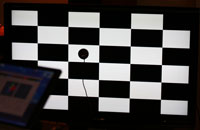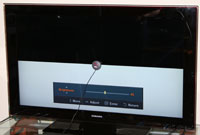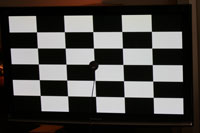What is Dynamic Contrast Ratio vs. Native Contrast Ratio?
By Jack Burden
 First, a quick lesson in contrast ratio. Contrast ratio is simply the ratio between the brightest white measurement and the darkest black measurement. A recent example of the ratio is 10,000:1 meaning there are 9,998 shades of gray between the darkest black and the brightest white that the TV will produce. One of the big problems with this ratio is that there is no standardized testing procedure by which all manufacturer's must measure and report the ratio. We have our own standardized procedure for the contrast ratio which is to measure white and black levels on an ANSI checkerboard pattern after having previously calibrated the TV to a D6500K color temperature picture setting.
First, a quick lesson in contrast ratio. Contrast ratio is simply the ratio between the brightest white measurement and the darkest black measurement. A recent example of the ratio is 10,000:1 meaning there are 9,998 shades of gray between the darkest black and the brightest white that the TV will produce. One of the big problems with this ratio is that there is no standardized testing procedure by which all manufacturer's must measure and report the ratio. We have our own standardized procedure for the contrast ratio which is to measure white and black levels on an ANSI checkerboard pattern after having previously calibrated the TV to a D6500K color temperature picture setting.
 Some might call dynamic contrast a very non-dynamic specification for the fact that it has little to do with reality and everything to do with fantasy. The calculation manufacturer's use to generate wild dynamic contrast ratio measurements is anyone's guess. Some recent LCD-LED TVs have reported dynamic contrast ratio of 7 million:1. Our best approximation is that they (manufacturer's) derive these figures is by measuring different input signals from an isolated panel with an extremely photosensitive measuring device. The TV is turned off to measure black, while tweaking to full power and contrast settings to measure white.
Some might call dynamic contrast a very non-dynamic specification for the fact that it has little to do with reality and everything to do with fantasy. The calculation manufacturer's use to generate wild dynamic contrast ratio measurements is anyone's guess. Some recent LCD-LED TVs have reported dynamic contrast ratio of 7 million:1. Our best approximation is that they (manufacturer's) derive these figures is by measuring different input signals from an isolated panel with an extremely photosensitive measuring device. The TV is turned off to measure black, while tweaking to full power and contrast settings to measure white.
 Native contrast ratio is a narrower measurement generated also by manufacturers to denote that the ratio is confined at least to white and black measurement from the same screen at the same time from the same source. This would compare to our ANSI checkerboard pattern. However, the manufacturer may still be using the highest contrast ratio setting for the TV (even from the service menu which consumers do not have access to). Certainly the TVs are not set to a standard color temperature settings when calculating the measurement. In sum, native contrast is a better measurement than dynamic contrast – but is also highly exaggerated, flawed and unregulated.
Native contrast ratio is a narrower measurement generated also by manufacturers to denote that the ratio is confined at least to white and black measurement from the same screen at the same time from the same source. This would compare to our ANSI checkerboard pattern. However, the manufacturer may still be using the highest contrast ratio setting for the TV (even from the service menu which consumers do not have access to). Certainly the TVs are not set to a standard color temperature settings when calculating the measurement. In sum, native contrast is a better measurement than dynamic contrast – but is also highly exaggerated, flawed and unregulated.
Plasma technology has long trumped LCD TVs in our contrast ratio testing until recently. A few LCD TVs have actually caught up with some of the recent plasma TVs owing to exceptional brightness. We recently reviewed an LCD TV with a post calibration ANSI measured contrast of 5408:1 - the highest we've evern tested.









